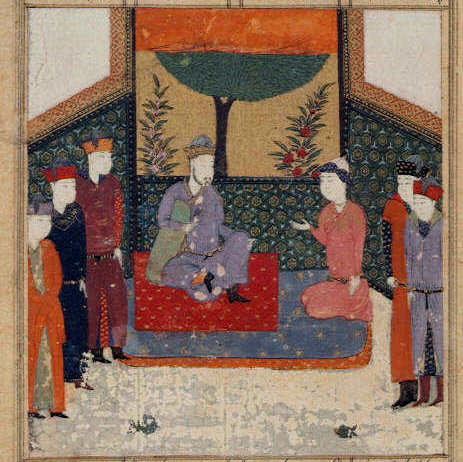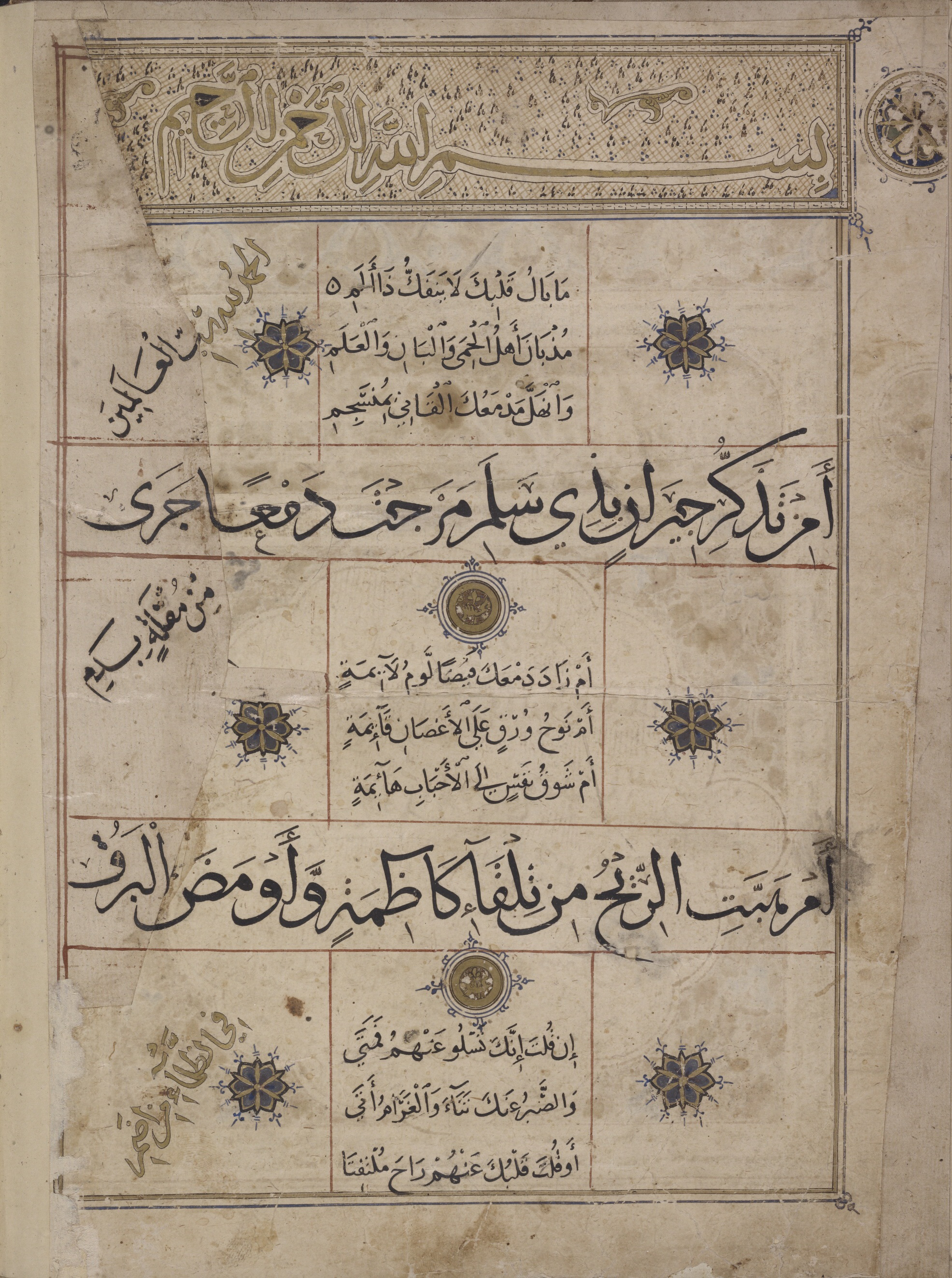|
Ilāhī-Nāma
The ''Ilāhī-Nāma'' (Persian: الهی نامه, "Book of God" or "Book of the Divine") is a 12th century Persian poem by the Sufi apothecary-poet, Attar of Nishapur (c. 1145–1221). It is made of roughly 6500 verses and features anecdotal stories varying greatly in length, with some only 3 verses long and others around 400 verses long. Attar endeavored to open the "door to the divine treasure" with this poem and he believed that the final work has praised Muhammad in a manner beyond any poet before or after himself. Background Work on the poem began around the same time as his ''Moṣībat-nāma'', all while Attar worked in a popular pharmacy in Nishapur, Greater Khorasan, during the age of the Seljuk Empire. During his time as an apothecary and physician, Attar remained busy with and affected by the ailments of his customers and his ''Ilāhī-Nama'' reflects what he learned during his time at the pharmacy. Attar spent his later years in Nishapur, where he remained comforta ... [...More Info...] [...Related Items...] OR: [Wikipedia] [Google] [Baidu] |
Attar Of Nishapur
Abū Ḥamīd bin Abū Bakr Ibrāhīm (c. 1145 – c. 1221; fa, ابو حامد بن ابوبکر ابراهیم), better known by his pen-names Farīd ud-Dīn () and ʿAṭṭār of Nishapur (, Attar means apothecary), was a PersianRitter, H. (1986), “Attar”, Encyclopaedia of Islam, New Ed., vol. 1: 751-755. Excerpt: "ATTAR, FARID AL-DIN MUHAMMAD B. IBRAHIM.Persian mystical poet.Farīd al-Dīn ʿAṭṭār, in Encyclopædia Britannica, online edition - accessed December 2012./ref> poet, theoretician of Sufism, and hagiographer from Nishapur who had an immense and lasting influence on Persian poetry and Sufism. He wrote a collection of lyrical poems and number of long poems in the philosophical tradition of Islamic mysticism, as well as a prose work with biographies and sayings of famous Muslim mystics. Manṭiq-uṭ-Ṭayr (''The Conference of the Birds)'' and '' Ilāhī-Nāma'' (''The Book of Divine)'' and Memorial of the Saints are among his best known works. Biograph ... [...More Info...] [...Related Items...] OR: [Wikipedia] [Google] [Baidu] |
Persian Language
Persian (), also known by its endonym and exonym, endonym Farsi (, ', ), is a Western Iranian languages, Western Iranian language belonging to the Iranian languages, Iranian branch of the Indo-Iranian languages, Indo-Iranian subdivision of the Indo-European languages. Persian is a pluricentric language predominantly spoken and used officially within Iran, Afghanistan, and Tajikistan in three mutual intelligibility, mutually intelligible standard language, standard varieties, namely Iranian Persian (officially known as ''Persian''), Dari, Dari Persian (officially known as ''Dari'' since 1964) and Tajik language, Tajiki Persian (officially known as ''Tajik'' since 1999).Siddikzoda, S. "Tajik Language: Farsi or not Farsi?" in ''Media Insight Central Asia #27'', August 2002. It is also spoken natively in the Tajik variety by a significant population within Uzbekistan, as well as within other regions with a Persianate society, Persianate history in the cultural sphere of Greater Ira ... [...More Info...] [...Related Items...] OR: [Wikipedia] [Google] [Baidu] |
Fana (Sufism)
Fanaa ( ar, فناء ') in Sufism is the "passing away" or "annihilation" (of the self).Harmless, William. ''Mystics''. New York: Oxford University Press, 2008 Fana means "to die before one dies", a concept highlighted by famous notable Persian mystics such as Rumi and later by Sultan Bahoo. There is controversy around what Fana exactly is, with some Sufis defining it as the annihilation of the human ego before God, whereby the self becomes an instrument of God's plan in the world ( Baqaa).Yaran, Cafer. Muslim religious experiences. Alister Hardy Religious Experience Research Centre, 2004. Other Sufis interpret it as breaking down of the individual ego and a recognition of the fundamental unity of God, creation, and the individual self. Persons having entered this enlightened state are said to obtain awareness of an intrinsic unity (Tawhid) between Allah and all that exists, including the individual's mind. This second interpretation is condemned as heretical by orthodox Islam. ... [...More Info...] [...Related Items...] OR: [Wikipedia] [Google] [Baidu] |
Religious Syncretism In Asia
Religion is usually defined as a social-cultural system of designated behaviors and practices, morals, beliefs, worldviews, texts, sanctified places, prophecies, ethics, or organizations, that generally relates humanity to supernatural, transcendental, and spiritual elements; however, there is no scholarly consensus over what precisely constitutes a religion. Different religions may or may not contain various elements ranging from the divine, sacred things, faith,Tillich, P. (1957) ''Dynamics of faith''. Harper Perennial; (p. 1). a supernatural being or supernatural beings or "some sort of ultimacy and transcendence that will provide norms and power for the rest of life". Religious practices may include rituals, sermons, commemoration or veneration (of deities or saints), sacrifices, festivals, feasts, trances, initiations, funerary services, matrimonial services, meditation, prayer, music, art, dance, public service, or other aspects of human culture. Religions have ... [...More Info...] [...Related Items...] OR: [Wikipedia] [Google] [Baidu] |
Religious Pluralism
Religious pluralism is an attitude or policy regarding the diversity of religious belief systems co-existing in society. It can indicate one or more of the following: * Recognizing and tolerating the religious diversity of a society or country, promoting freedom of religion, and defining secularism as neutrality (of the state or non-sectarian institution) on issues of religion as opposed to opposition of religion in the public forum or public square that is open to public expression, and promoting friendly separation of religion and state as opposed to hostile separation or antitheism espoused by other forms of secularism. * Any of several forms of religious inclusivism. One such worldview holds that one's own religion is not the sole and exclusive source of truth, and thus acknowledges that at least some truths and true values exist in other religions. Another concept is that two or more religions with mutually exclusive truth claims are equally valid; this may be consi ... [...More Info...] [...Related Items...] OR: [Wikipedia] [Google] [Baidu] |
Sufi Literature
Sufi literature consists of works in various languages that express and advocate the ideas of Sufism. Sufism had an important influence on medieval literature, especially poetry, that was written in Arabic, Persian, Turkic and Urdu. Sufi doctrines and organizations provided more freedom to literature than did the court poetry of the period. The Sufis borrowed elements of folklore in their literature. The works of Nizami, Nava'i, Hafez, Sam'ani and Jami were more or less related to Sufism. The verse of such Sufi poets as Sanai (died c. 1140), Attar (born c. 1119), and Rumi (died 1273) protested against oppression with an emphasis on divine justice and criticized evil rulers, religious fanaticism and the greed and hypocrisy of the orthodox Muslim clergy. The poetic forms used by these writers were similar to the folk song, parable and fairy tale. Background Sufi literature written in Persian flourished from the 12th to 15th centuries. Later major poets linked with the Sufi tra ... [...More Info...] [...Related Items...] OR: [Wikipedia] [Google] [Baidu] |
Persian Poems
Persian may refer to: * People and things from Iran, historically called ''Persia'' in the English language ** Persians, the majority ethnic group in Iran, not to be conflated with the Iranic peoples ** Persian language, an Iranian language of the Indo-European family, native language of ethnic Persians *** Persian alphabet, a writing system based on the Perso-Arabic script * People and things from the historical Persian Empire Other uses * Persian (patience), a card game * Persian (roll), a pastry native to Thunder Bay, Ontario * Persian (wine) * Persian, Indonesia, on the island of Java * Persian cat, a long-haired breed of cat characterized by its round face and shortened muzzle * The Persian, a character from Gaston Leroux's ''The Phantom of the Opera'' * Persian, a generation I Pokémon species * Alpha Indi, star also known as "The Persian" See also * Persian Empire (other) * Persian expedition (other) or Persian campaign * Persian Gulf (other) ... [...More Info...] [...Related Items...] OR: [Wikipedia] [Google] [Baidu] |
The Conference Of The Birds
''The Conference of the Birds'' or ''Speech of the Birds'' ( fa, منطق الطیر, ''Manṭiq-uṭ-Ṭayr'', also known as ''Maqāmāt-uṭ-Ṭuyūr''; 1177) is a Persian poem by Sufi poet Farid ud-Din Attar, commonly known as Attar of Nishapur. The title is taken directly from the Qur’an27:16 where Sulayman ( Solomon) and Dāwūd (David) are said to have been taught the language, or speech, of the birds (''manṭiq al-ṭayr''). Attar’s death, as with his life, is subject to speculation. He is known to have lived and died a violent death in the massacre inflicted by Genghis Khan and the Mongol army on the city of Nishapur in 1221, when he was seventy years old. Synopsis In the poem, the birds of the world gather to decide who is to be their sovereign, as they have none. The hoopoe, the wisest of them all, suggests that they should find the legendary Simorgh. The hoopoe leads the birds, each of whom represents a human fault which prevents human kind from attaining en ... [...More Info...] [...Related Items...] OR: [Wikipedia] [Google] [Baidu] |
Sufism
Sufism ( ar, ''aṣ-ṣūfiyya''), also known as Tasawwuf ( ''at-taṣawwuf''), is a mystic body of religious practice, found mainly within Sunni Islam but also within Shia Islam, which is characterized by a focus on Islamic spirituality, ritualism, asceticism and esotericism. It has been variously defined as "Islamic mysticism",Martin Lings, ''What is Sufism?'' (Lahore: Suhail Academy, 2005; first imp. 1983, second imp. 1999), p.15 "the mystical expression of Islamic faith", "the inward dimension of Islam", "the phenomenon of mysticism within Islam", the "main manifestation and the most important and central crystallization" of mystical practice in Islam, and "the interiorization and intensification of Islamic faith and practice". Practitioners of Sufism are referred to as "Sufis" (from , ), and historically typically belonged to "orders" known as (pl. ) – congregations formed around a grand who would be the last in a chain of successive teachers linking back to Muh ... [...More Info...] [...Related Items...] OR: [Wikipedia] [Google] [Baidu] |
An-Nur
Light ( ar, النور, ; The Light) is the 24th chapter of the Quran with 64 verses. The surah takes its name, An Nur, from verse 35. Summary *1 This chapter revealed from heaven *2-3 Law relating to fornication *4-5 Punishment for defaming virtuous women *6-10 Law relating to charge of adultery when made by a husband against his wife *11-20 Aisha's slanderers reproved, and their punishment *21 Believers warned against evil deeds *22 The rich to forgive the poor, and bestow charity upon them *23-25 False accusers of virtuous women for ever accursed *26 Wicked men and women condemned to each other's society *27-29 Manners to be observed in visiting each other's homes *30-31 Pious men and women exhorted to modest demeanour *32 Marriageable women to be married if possible *32 Men-servants and maid-servants to be married when honest *33 Unmarried Muslims exhorted to continence *33 Masters to encourage slaves to purchase their freedom *34 The Quran an admonition to the piou ... [...More Info...] [...Related Items...] OR: [Wikipedia] [Google] [Baidu] |
Celestial Spheres
The celestial spheres, or celestial orbs, were the fundamental entities of the cosmological models developed by Plato, Eudoxus, Aristotle, Ptolemy, Copernicus, and others. In these celestial models, the apparent motions of the fixed stars and planets are accounted for by treating them as embedded in rotating spheres made of an aetherial, transparent fifth element (quintessence), like jewels set in orbs. Since it was believed that the fixed stars did not change their positions relative to one another, it was argued that they must be on the surface of a single starry sphere. In modern thought, the orbits of the planets are viewed as the paths of those planets through mostly empty space. Ancient and medieval thinkers, however, considered the celestial orbs to be thick spheres of rarefied matter nested one within the other, each one in complete contact with the sphere above it and the sphere below.Lindberg, ''Beginnings of Western Science'', p. 251. When scholars applied Pto ... [...More Info...] [...Related Items...] OR: [Wikipedia] [Google] [Baidu] |






.jpg)
